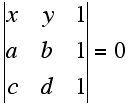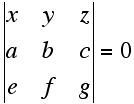
Geometric Structures: Session 3 (Comments and Loose Ends)
Prepared by:
Joseph Malkevitch
Department of Mathematics
York College (CUNY)
Jamaica, New York 11451
email:
malkevitch@york.cuny.edu
web page:
http://york.cuny.edu/~malk/
1. The real projective plane has a model which uses three coordinates instead of two to represent a point. In this homogeneous coordinate system all the triples except (0, 0, 0) are used to represent points. Remember that for lines in the Euclidean plane, Ax + By + C = 0 and the corresponding projective line Ax + By + Cz = 0 there is no line corresponding to the triple where A, B, C are all zero.
2. One can use the theory of determinants to write down in very simple form the equation of a line through two points. Thus, the line m through the two points (a, b) and (c, d) is:

Note that if one substitutes the value a and b (or c and d) for x and y, respectively, then two rows of the determinant are identical. Thus, the value of the determinant will be zero. Hence, the point with coordinates (a, b) or (c,d) will satisfy this equation. Also, if (e, f) is on the line m, if we substitute e for x and f for y the result will be zero. Thus, we have a very nice way of telling whether or not three distinct points are concurrent, that is, lie on a line.
3. There is also a way of determining the line m through two points (a, b, c) and (e, f, g) in the real projective plane. The equation is given by:

Again, the point (u, v, and w) will also be on m if when one sets x to u, y to v, and z to w the value of the determinant evaluates to zero.
There are some disadvantages to the theory of determinants. Large determinants are computationally intensive to evaluate. (Thus, though Cramer's Rule gives an elegant theoretical way to write down the unique solution of an nxn system of linear equations (e.g. n equations in n variables), Gauss elimination is a much more computationally efficient algorithm.) The other disadvantage of determinants is that the theoretical foundations (proofs that their properties hold) are not totally transparent. Despite this, K-16 students do not seem to mind dealing with determinants despite the fact they may not have a solid theoretical basis for using them, since they have a concreteness that is "comforting." The algorithms for finding the answers always seem to work!
3. In Euclidean geometry we are accustomed to writing coordinates for points and equations for lines. In the real projective plane we can again write coordinates for points and equations for lines. Can we write coordinates for lines and equations for points? The answer in the projective plane is that there are compelling reasons to do so!
Suppose we want to write down the equation of the line which goes through (2, 4, 1) and (-2, 0, 1)? Now, suppose we write down the EQUATION of the point (2, 4, 1)! To avoid confusion with the equations of lines we will use the letters a, b, and c for the variables in equations of our two points. Thus, we have the equations:
2a + 4b + c = 0
-2a + 0b + c = 0
This system has the solution a = -1, b = 1, c = -2. Note that this system is such that it has infinitely many solutions. However, this is what you should expect because there are infinitely many triples which represent the same line. Thus, (-1, 1, -2) are the coordinates of the COORDINATES of the equation of the line which passes through our two points. You can easily verify that the line -x + y - 2z = 0 does indeed pass through our two given points because the coordinates of the points satisfy the equations of the line. If this equation is multiplied by the nonzero constant k, one gets another equation which passes through the same point. Say k = 2 is 2, then the coefficients would be -2, 2, -4. You can easily verify that if one sets a = -2, b = 2,and c = -4 which is ANOTHER solution to the system of two equations in two unknowns we were working with above.
When one writes an equation of the point (3, 0, 1) as 3a + c = 0 then all the lines which pass through (3, 0, 1) have COORDINATES which satisfy this equation. For example, (-1, 3, 3) satisfies this equation. Thus the line with equation -x + 3y + 3z = 0 passes through the point (3, 0, 1). Again, note that any multiple of this line will also pass through the point (3, 0, 1). Thus, we refer to (-1, 3, 3) as the coordinates of the line -x + 3y + 3z = 0.
It takes a while to absorb and get used to this point of view but what it means is that when finding the line though two points or the point on two lines one can do calculations which look identical!